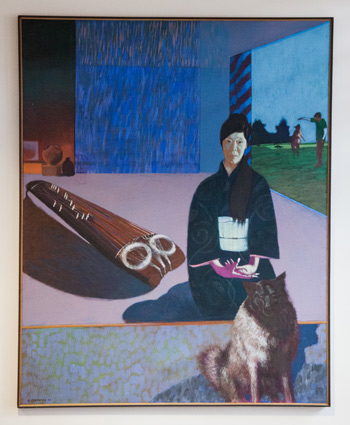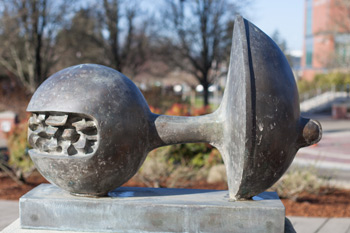Joy of benevolent art
Family tragedy brings color and dimension to otherwise bland campus spaces
by Rhonda Morin
![]() Listen to Yoko Ito-Gates play koto
Listen to Yoko Ito-Gates play koto
Situated near the walkway in front of the Cannell Library is an unlabeled bronze sculpture that at first glance looks like a tipped-over shield or a breast on a stick. One looks a little closer, wonders and chuckles at the strangeness of it, which is precisely what the owner of the piece had in mind.
 The artwork is part of a collection that has been on loan to Clark College for more than 20 years from the estate of Yoko Ito-Gates and Allen Gates. Their collection, from sculptures, to oil paintings to pencil drawings, represents a life of collecting art that was fascinating and bizarre, according to their daughter Joemy Ito-Gates.
The artwork is part of a collection that has been on loan to Clark College for more than 20 years from the estate of Yoko Ito-Gates and Allen Gates. Their collection, from sculptures, to oil paintings to pencil drawings, represents a life of collecting art that was fascinating and bizarre, according to their daughter Joemy Ito-Gates.
Joemy’s earliest memories are of a house chock-full of modern art. Her father, Allen, was a trained classical pianist and occasional composer and one-time Clark College music instructor. Her mother, Yoko, a professional koto player who played Carnegie Hall, was a graceful and refined woman with an independent streak that propelled her from her homeland in Japan to a very different life in the United States.Collecting art and creating music were passions they shared before their death at an early age from AIDS – a mysterious new disease at the time.
Joemy remembers her mother saying “I’d rather eat hotdogs every day and have beautiful art around me, than no art at all.”
The piece outside of Cannell Library is “Naga Spore #2” by renowned Pacific Northwest artist James Lee Hansen. His portfolio includes a vocabulary of shapes in sculpture form. On a stairwell wall in the library the round cast aluminum “Alpha Delta Foxtrot” by Pendleton,Ore., artist Tom Morandi stands guard as students pass beneath it. People lunching in Clark’s formal dining room regularly walk by the oil-on-canvas painting “All is Well” by Suzanne Duryea, that depicts tomatoes and carrots.
Joemy holds close the memory of her parents’ fondness for art. She recalls funny anecdotes about some of the pieces,like the time her mother pinched the nipple of the “Naga Spore #2.” Joemy appreciates art today and credits her folks for exposing her to the art scene as a child.
She was eight when her mother died and 10 when her father passed. Since she was born and raised in America,her parents were adamant that she remain in the U.S. after their death instead of being sent to family in Japan. It was friends in Berkeley, Calif., Joemy’s godparents, who were entrusted with her upbringing.
Chance meeting
Allen was the black sheep of the family. But his working-class father, a welder by trade, and mother, who dished out hot lunches in a Vancouver school cafeteria, came to support their son’s passion to be a professional pianist as he studied at Lewis & Clark College and signed up for a study-abroad program in Japan.
Yoko was rehearsing on the 13-stringed koto instrument with a friend when they spotted the American, lost and wandering down a hallway at Kyoto University. Knowing she could speak English, her friend nudged Yoko to help the tall, handsome man. Yoko got up and crossed the threshold from a life as a measured Japanese woman to greet the man who would become her husband and embolden her artistic freedom.
Yoko was born in the city of Hamamatsu in Western Shizuoka Prefecture to Buddhist parents. She began studying the koto at age five and practiced the six-foot long, wooden instrument constantly. In fact, studying was something Yoko took very seriously. Joemy recalls hearing stories about her mother studying English as a child in the bathroom by flashlight, inferring that her mother had a rebellious nature early in her life.
Yoko and Allen fell in love during Allen’s study abroad and wanted to marry. But Yoko’s father disapproved and told them they should wait one year and then could only marry in Japan. Allen returned to Japan in 1969 and the two married in a Christian wedding in her home town.
[quote style=”boxed”]”I’d rather eat hotdogs every day and have beautiful art around me, than no art at all.” ~ Yoko Ito-Gates[/quote]They moved to Vancouver and Allen landed a job at Clark College in the music department. Yoko pursued her koto career by touring in the U.S.and Canada and teaching. She established the group Rei In Kai in Berkeley, Calif., to promote the study and performance of Japanese music. The couple had Joemy 11 years after they were married.
When Joemy was two, the family moved to Brooklyn,N.Y., and then moved every one to two years after that as a restless Allen sought rewarding work within the art field. One constant during that time was the art – new pieces were regularly being added to their apartments.
“I remember beautiful, interesting and weird art surrounding me as a child,” said Joemy. “They had fun with the art they collected.”
Gifts from heartache
Collecting art was personal and meaningful for the couple.Allen’s and Yoko’s life took a dim turn in the 1980s when they were diagnosed with a fatal disease. They were deliberate in their arrangements for the essential people and pieces in their lives before their deaths.
Allen was diagnosed with HIV first. Yoko contracted the virus that causes AIDS from her husband shortly thereafter,according to Joemy. It was a strange new illness that was first officially recognized in the U.S. in 1981, but was feared and stigmatized by the public.
They both grew ill rapidly as the virus ravaged their bodies.There were no medical treatments at the time to ease their suffering as little was known about the disease. The diagnosis was a death sentence.
Compounding the body aches and weight loss was the public humiliation and discrimination people diagnosed with HIV and AIDS endured. Allen, Yoko and Joemy each experienced different types of judgment. Allen was encouraged to resign from his job by one of his employers because of his health. The nurses in the hospital ward where Yoko was treated feared touching her. Even little Joemy felt a change in how people treated her.
 “I remember as a kid the shift in the adults’ responses to me. They weren’t as nice to me as they once had been,” she recalls.
“I remember as a kid the shift in the adults’ responses to me. They weren’t as nice to me as they once had been,” she recalls.
Following her mother’s death, Joemy kept in touch with the doctor who treated her. Years later, while having dinner with the doctor in San Francisco, where Joemy now lives with her husband, the doctor reflected on how Yoko helped change the perspective of his staff on the hospital floor.
The nurses had preconceived notions of people who contracted HIV. “Then they met my mother – sweet, gentle and kind,” said Joemy.
Yoko transformed the medical staff ‘s perception from stereotypes to understanding that all people were susceptible to the virus.
Before Yoko died at age 44 in 1988 and Allen in 1990 at the age of 47, the couple decided to loan their collection to Clark College. They were confident that the college would appreciate the art and it would be safe and loved.
“Clark was the first place my father thought of. He knew the college would display the art and take care of it. It was a natural fit to have the art at Clark College,” said Joemy.
In the decades that have passed since the art first came to campus, Joemy has been pleased with the caring attention the college has given the collection. “The art has been beautifully maintained, it looks wonderful on campus, particularly the ‘Naga Spore’ piece outside of the library,” she said.
A different take
Thirteen pieces of the collection came to the college including a three-panel painting by Jay Backstrand called “There was a Crippled Man” that hangs in the eLearning entrance near Cannell Library. A portrait of Yoko dressed in a kimono with her koto and Allen in the background with one of the family’s dogs greets students as they enter the library’s breezeway. Additionally, a sculpture titled “Fruit Pole” by local artist Joanne Peekema is one of several Peekema pieces located on campus that brighten otherwise empty spaces.
“Art enhances the physical space of the college,” said Phil Sheehan, Clark’s director of information technology and a member of the college’s art selection committee. “If it creates a little controversy I like that too, because art stretches people’s horizons.” Sheehan fears that if Clark College didn’t have visual art the walls would be covered with inspirational posters or remain blank and lifeless.
When Allen Gates worked at Clark in the mid-1970s, he joined forces with Richard Stensrude, a 25-year art professor and designer of Clark’s most recognizable feature—the Chime Tower, to raise private funds to purchase the sculpture called “The Guardian” that stands between the south facing Penguin Union Building and Andersen Fountain. They worked directly with artist James Lee Hansen to secure the piece, and later Allen bought Hansen’s “Naga Spore #2” for his personal collection.
Acquiring art collections is rare. The college has vast white spaces on campus that could be livened up with paintings, drawings, sculpture or other visual art, according to Sheehan.
The college is always open to talking with collectors or artists about displaying their art or accepting a donation. The display of art helps Clark College foster a diverse college community by easing ethnic, racial and cultural divides, he said.
This year, a part of the Ito-Gates collection will return to Joemy as she and her husband prepare to start a family.
“It is important to me that our children grow up around the artwork my parents collected as it is a reflection of grandparents they will never have the opportunity to meet. Just as my parents instilled a love for creativity, beauty and art in me, I want to pass that on to my children,” she said.
Leaving will be “Alpha Delta Foxtrot,” an aluminum piece by local artist Tom Morandi, the Joanne Peekema sculpture, the portrait and several canvases.
Joemy has donated several pieces to Clark including “Naga Spore #2,” a ceramic sculpture by Gary Smith, the welded steel “Table III” by Lee Kelly, and two paintings by Suzanne Duryea. These will continue to give us pause while we wonder what the artist was thinking or dreaming.

